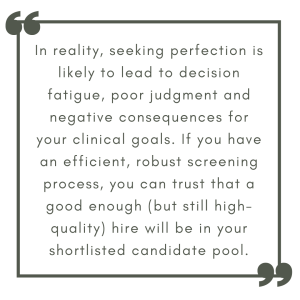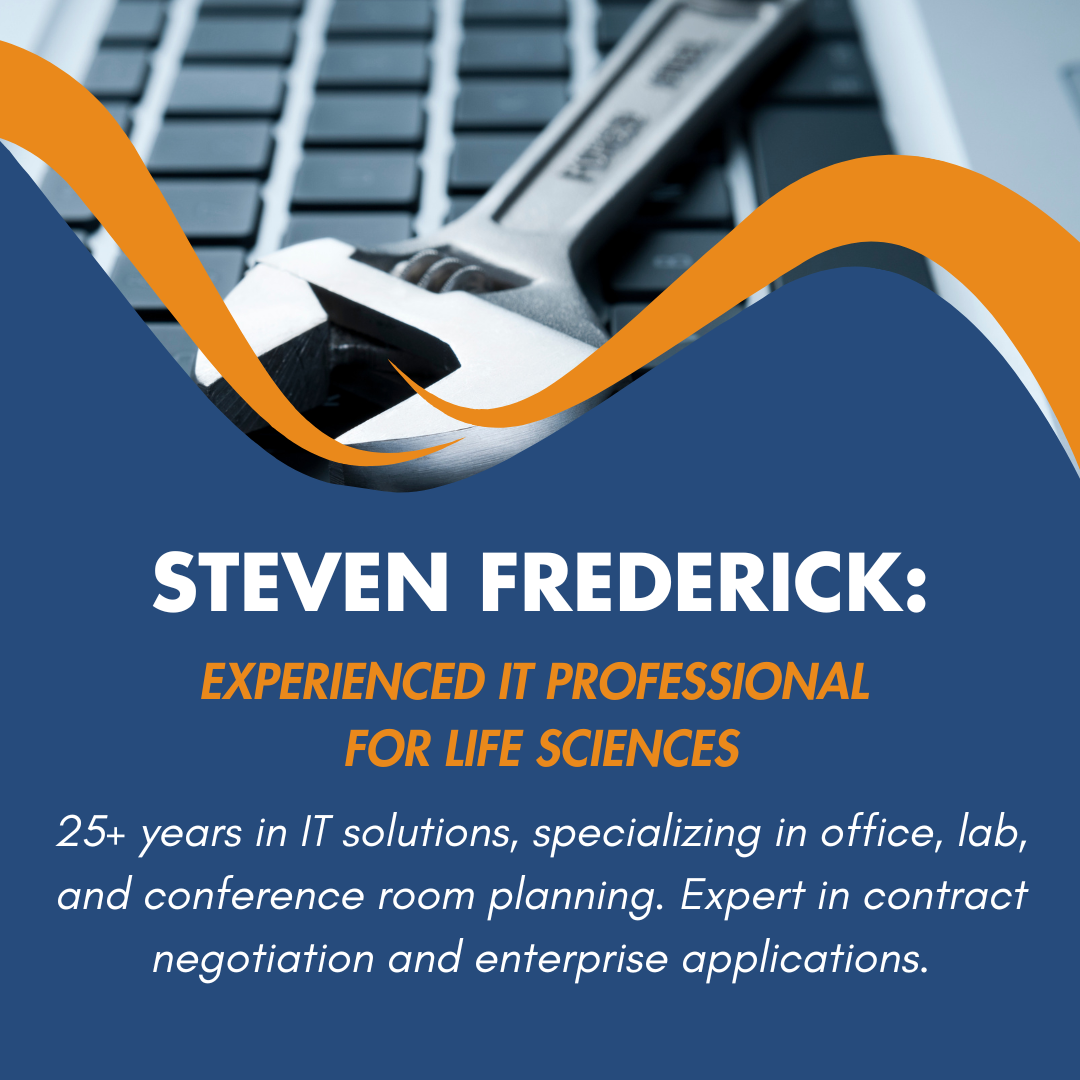Why more is not always better when it comes to job candidates, and what to do about it.
Imagine you’re a clinical operations executive working for a Series B company that just filed a Clinical Trial Application (CTA). Right now, you’re in a time crunch to find a clinical trial manager (CTM). And not just any CTM—you want someone top-notch who fits your culture and can scale along with the company.
 You’ve hired CTMs before and remember how few candidates actually met competency requirements and cultural fit. At the time, you compromised—it was inevitable. And ultimately some of those hires worked out while others didn’t.
You’ve hired CTMs before and remember how few candidates actually met competency requirements and cultural fit. At the time, you compromised—it was inevitable. And ultimately some of those hires worked out while others didn’t.
Now it’s 2024, and we’re in a vastly different landscape. There’s far more competitive talent available than before. So, hiring your CTM should be a piece of cake, right? Maybe. But more likely not.
Ironically, this embarrassment of riches makes it harder to hire precisely because you have so many good candidates and you’re struggling to make up your mind. You think to yourself: What if the perfect candidate is out there—someone with person A’s personality but person C’s experience?
Alas, life doesn’t work that way (sorry to be the bearer of bad news). The reality is it’s taking you just as long as ever to hire someone, even though you now have more qualified candidates.
Welcome to the paradox of choice
When faced with a flood of candidates, it’s natural to assume that finding the right one should be fairly simple. But often, having too much information hinders our ability to make a decision. It’s the paradox of choice.
The idea behind the “paradox of choice” is not new. Barry Schwartz first wrote about it in his 2004 book of the same name. Schwartz made the argument that reducing consumer choices alleviated anxiety, and ultimately led to quicker and more satisfying decisions.
 Think of it this way: You’re standing in the grocery store’s cereal aisle, where you’re trying to decide between 10 brands and types of granola. Each has a different flavor and different ingredients, which means you’ll need to spend time studying the merits of all 10. This can lead to analysis paralysis, where you walk out the door without granola because the choices are just too overwhelming. On the other hand, if there were only two types of granola in that aisle, making a choice would be simple.
Think of it this way: You’re standing in the grocery store’s cereal aisle, where you’re trying to decide between 10 brands and types of granola. Each has a different flavor and different ingredients, which means you’ll need to spend time studying the merits of all 10. This can lead to analysis paralysis, where you walk out the door without granola because the choices are just too overwhelming. On the other hand, if there were only two types of granola in that aisle, making a choice would be simple.
This paradox of choice holds true for talent acquisition, too. In a biotech hiring landscape where submitting a job application requires simply clicking a button and the candidate is often able to work remotely, the number of qualified candidates for each role is increasing year over year. The paradox of choice is likely to disrupt your recruitment process.
Why the perfect candidate isn’t worth it
Let’s return to our clinical operations executive’s dilemma. At first glance, taking an extra month or two to find and decide on the “perfect” candidate seems like the correct choice. But if you can typically make a decision in four weeks, yet you’re taking eight or more while trying to maximize your search, you’ll find clear costs as you leave that position unfilled.
First, you’re heaping extra work onto other team members, creating added stress. And you can’t always rely on consultants or contract research organizations (CROs) to come through. Ultimately, this impacts the quality of work and quality of life for current employees, and can lead to increased turnover and missed deadlines.
Second, if you delay onboarding a CTM, your clinical trial may also be delayed. This can add up to costs that are several times the CRM’s salary. And keep in mind that once you begin the trial, it will likely have its own delays in patient recruitment—which alone can ultimately cost you up to $8 million in revenue per day.
Third, waiting too long could lead you to lose good candidates who get snapped up by competitors, while your company is trying to reach for the stars. Even if you identify a star and make them an offer, they may not accept it, causing you to start the whole process over, as the previous acceptable contenders are no longer available.
Meanwhile, your competitors are making strides, getting closer to the finish line as you hold out for a marginally better CTM hire. By the time you’ve onboarded your dream candidate, you could be out of the game. Maybe your stock’s even dropped, which in turn leads to investors pulling away.
Schwartz’s theory should be ringing in the biotech recruiter and hiring company’s ear right now. Taking too much time to hire can delay FDA approvals, and harm biotech companies in monetary and non-monetary ways.
How to break out of the paradox of choice
Admittedly, this scenario paints a bleak picture. But it doesn’t have to be all doom and gloom.
While it’s easy to get lost in indecision when making your next hire, there are tried and true ways to streamline your recruitment process to ensure you get great hires in a timely manner.
Here are key insights on how to ensure your hiring process is not hamstrung by the paradox of choice.
1. Create a clear, consistent screening process.

The key is to establish detailed criteria on what you are looking for—and then stick to it. This will significantly reduce the number of unsuitable candidates who apply, and will help you easily weed them out. Your team can then focus its decision-making efforts on vetting qualified candidates who are truly good matches for the job.
2. Trim the interview process.
No one enjoys a prolonged interview process, especially busy biotech recruiters. One way to improve interview efficiency is by trimming the number of interviews for each candidate. Since you’ve already vetted candidates before the interview, don’t waste their time (or yours) asking them the same questions they submitted with their application.
Then, consider whether you can combine multiple interviewers in one session. For instance, you might conduct the initial interview alongside the hiring manager, or include several team members in one interview, rather than spreading out individual interviews over several days. This can further cut back on the time that hiring professionals, team members and candidates spend on the interview process.
3. Aim for good enough, not perfect.
When looking for the right candidate, we often think we need to find the “perfect” hire, which—spoiler alert—doesn’t exist. This can lead to hiring professionals falling into analysis paralysis as they seek more candidates in the pursuit of perfection.

4. Embrace technology, don’t run from it.
Many people have a love/hate relationship with technology. But if you haven’t already embraced technology’s role in the recruitment world, it’s time. You may want to invest in artificial intelligence (AI) to help you forecast whether a candidate could be a good fit, for instance.
Also consider picking a platform that gives candidates a link to schedule an interview on your calendar. It saves you both the time and hassle of coordinating across time zones and limits the number of emails. Embracing simple technology is a time (and sanity) saver for everyone.
5. Foster a culture of meeting recruitment deadlines.
Setting recruitment deadlines and sticking to them can help you meet your clinical goals and retain team respect. This is especially important when time is of the essence, and you can’t move your research forward without someone in that role. Meeting your hiring deadline is far more valuable than waiting for your dream candidate. It also creates trust among your team members, who know that you will do what you say you’re going to do, when you say you’re going to do it.
In short, having an excess of candidates for a CTM position sounds like a biotech recruiter’s dream. But it can quickly turn into a nightmare if you fall into the paradox of choice trap. Try these tips to keep your hiring process on track, save you time, and potentially prevent costly delays for your clinical trial.









